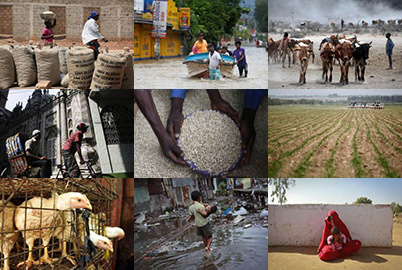LONDON (AlertNet) - Minorities and indigenous groups often bear the brunt of climate-related disasters and changing climate conditions, says a new report by Minority Rights Group International. Here are some examples, taken from "State of the World&${esc.hash}39;s Minorities 2008".
- KENYAN PASTORALISTS
: Increasingly severe and frequent droughts are forcing animal herders in Kenya&${esc.hash}39;s arid north to travel further in search of water. Dwindling water resources have also sparked deadly conflicts. Drought in 2005-06 led to a 70 percent fall in the size of cattle, goat and camel herds, reducing food supplies. Around 80 percent of pastoralists were left dependent on international food aid and their health deteriorated.
- ARCTIC SAMI PEOPLE
: The Arctic&${esc.hash}39;s 400,000 indigenous peoples include the Sami people of northern Norway, Sweden, Finland and Russia, who traditionally herd reindeer. Higher temperatures and increased rainfall are making it harder for reindeer to reach the lichen they feed on. And because the Arctic ice is thinning, some herding tracks are becoming dangerous, forcing people to find new routes. Sami culture - including language, songs, marriage and child-rearing - is intimately linked with reindeer herding, and if climate change makes that impossible, local people fear their way of life will be devastated.
- INDIA&${esc.hash}39;S DALITS
: In India, some 170 million people known as Dalits are physically, socially and economically excluded from the rest of society. Because of this, they were worst hit by the unusually severe monsoon floods in 2007. Many Dalits live in rickety homes in flood-prone areas outside main villages. They have often been the last to get emergency relief, if at all, as dominant groups get priority in aid distributions. An August 2007 survey by Dalit organisations of 51 villages found that 60 percent of the dead were Dalits, and none of the Dalit colonies attached to the main villages had been visited by government relief officials.
- EUROPEAN ROMA
: Housing conditions of Roma communities in Europe are notoriously unpleasant and unhealthy, but it&${esc.hash}39;s less well known that some are also at high risk of flooding. When Jarovnice in Slovakia suffered the worst floods in its history in June 1998, some 140 Roma homes were affected, compared with 25 non-Roma homes, and of the 47 people who died, 45 were Roma. Of these, 42 had lived in a shanty town in the flooded valley of the River Svinka, while non-Roma lived in a village higher up. In the Czech Republic city of Ostrava, which experienced severe flooding in 1997, Roma communities were treated very differently from "white" residents, who were resettled much faster and in superior accommodation.
- COLOMBIA&${esc.hash}39;S NASA PEOPLE
: Activists in Colombia warn that growing demand for biofuels has led to indigenous and Afro-descendant communities being displaced from their communal lands in the northwestern Choco region. The Nasa people say they&${esc.hash}39;ve been terrorised by paramilitary groups - often in the pay of large landowners - who have appropriated their land for palm-oil cultivation oil. Local leaders want the international community to pressure the Colombian government to protect the country&${esc.hash}39;s 92 indigenous groups, and keep promises to set aside land for indigenous reservations so they can preserve their traditional way of life.
Our Standards: The Thomson Reuters Trust Principles.

